Enjoying local flavours is an important part of travelling. Often certain dishes and even the entire cuisine are matched to a specific region or country. There are flavours that are recognised all over the world – such as Italian cuisine, Asian flavours and traditional Georgian dishes. Although the entire world is not aware of it, Latvia also has its own flavours. Flavours are inherited from recipe books written by grandmothers themselves.
Flavours that remind one of childhood, specific celebrations or special seasons. When going to Latvia, you definitely have to hear out the stories and enjoy these flavours!
Birch juice
In Latvia, the onset of spring is marked by the return of migratory birds, freshly blooming snowdrops and a full glass of birch juice. Yes, juice from birch trees! To collect this juice, a small hole is drilled in the birch tree, through which the juice flows – water that the wood has filtered out, giving it a slightly sweet, but fresh and refreshing flavour.
The time period for collecting this drink is short – it begins when the ground has thawed and the temperature rises above zero, and it must be stopped before the birch leaves begin to bloom.
Birch juice can be enjoyed fresh or bottled as a sparkling drink. When birch juice is fermented, champagne-like or sparkling wine-like birch juice is acquired as a result of the fermentation process. It is definitely one of the most unique drinks not only in Latvia, but all over the world.
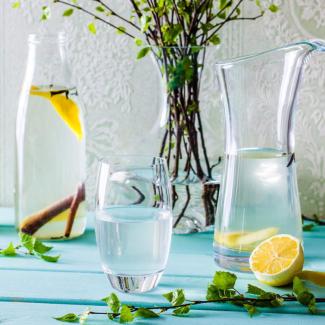
Photo: A.Andersone
Cold soup
There is only one soup that the Latvians associate with the beginning of summer, but for many foreigners it raises questions. Not only because the soup is not boiled and is served chilled, but also because it visually looks different from any other soup – it is bright pink.
Although there are many different variations of this soup today, it is traditionally made from beetroot (where the pink colour also comes from) and sour milk products, usually kefir, curdled milk or buttermilk. Boiled potatoes and eggs, sausage or other meat products, fresh cucumbers, spices and seasonal herbs – onions and dill – are added to it. Each family has its own one and only cold soup recipe. Families often argue about whether it is better to add mustard and vinegar to cold soup or replace these additives with something else.
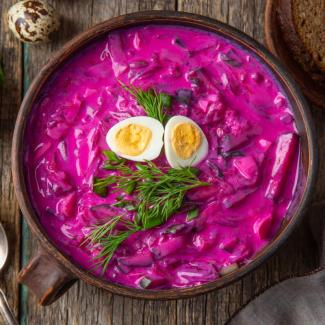
Līgo cheese
Līgo or Jāņi cheese is a product rich in traditions, which is placed on the table in Latvia at the Summer Solstice or Midsummer’s Night Celebration. There are rich traditions of tying and enjoying it – the ancient Latvians believed that the cheese wheel symbolises the Sun and brings good luck for live-stock breeding. The cheese is made from fresh milk by heating it and adding salt and caraway to it. It is caraway that distinguishes this cheese from other cheeses and gives it such a memorable flavour.
As with the champagne of Champagne, in order for the cheese to be sold under the name “Jāņu Cheese”, the manufacturer must be included in the Register of Traditional Specialities Guaranteed and the cheese must be produced in accordance with the product specification set out therein. Although the cheese can be bought in shops throughout the year, homemade caraway cheese is considered a special delicacy.
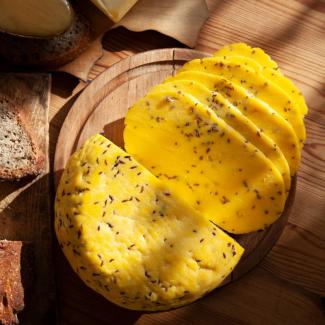
Quince
Quince is called the Latvian lemon. And there is a reason for it – it has a sour, lemon-like flavour, and each quince is rich in a substantial dose of vitamin C. The yellow fruit grows in bushes, which can very often be found in the yards of Latvian houses, as it does not require special care – quinces really enjoy the climate in Latvia. Their processing and preparation for storage is rich in traditions, as well as has been adapted to more modern methods.
Traditionally quince juice is squeezed, quince jam is made and the sweet and sour snack – candied quince – is made. One of the most common ways to preserve the flavour of quince is by boiling it in syrup. The flavour of quinces matches especially well with apples, pears and even pumpkin! A more unusual way to preserve the unique flavour of quinces is to make wine.
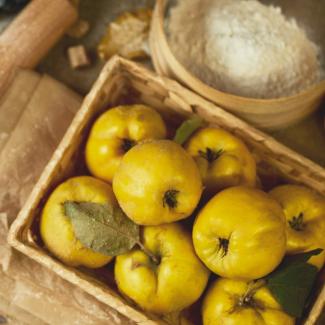
Chanterelles
The Latvians and the forest are inseparable. Especially in summer and autumn, when the to-do list of almost every family includes heading to the forest for berry and mushroom picking. And if you go for mushroom picking, then the task is to pick a full basket of chanterelles! It may be chanterelle sauce with new potatoes, chanterelle casserole, pickled chanterelles or any other mushroom dish – the taste of the yellow, curly mushrooms cannot be compared to anything else.
One of the reasons why chanterelle is such a popular mushroom is likely its resistance to pests – it is almost impossible to find a worm-infested chanterelle. And besides, it is so easy to cook! It can be baked without being boiled previously, or it can be dried, salted or pickled. Picking of chanterelles can be easily combined with a beautiful walk, as they usually grow in coniferous or mixed woods.
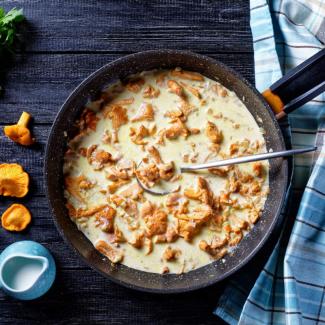
Grey peas
Every Latvian associates grey peas with Christmas. During this holiday grey peas with bacon are traditionally placed on the table as one of the main dishes. In Latvian folklore the pea symbolises prosperity and vitality. Grey peas are a very easy food to cook, but the process itself takes quite long, because the peas must be soaked in water before they are boiled. Usually they are prepared and served with bacon, smoked pork and onions or other toppings.
In modern Latvian cuisine grey peas are compared to Turkish peas or chickpeas and can be used to prepare hummus, added to salads or even curry! This is a product of Latvia that is included in the European Union (EU) Register of National Products, which includes foods that are traditionally used in the specific area and the recipes of which are proven to be passed on from one generation to the next for at least 25 years. Grey peas are a true flavour of Latvia!

Photo: R.Hofmanis
Candy “Gotiņa”
The flavours of Latvia are unimaginable without sweets, that are enjoyed after every rich meal. Candy “Gotiņa” is a unique sweet that is close to the heart of every Latvian, not only because of its sweet flavour but also for its gooey consistency. At the very beginning, the traditional candy “Gotiņa” was cooked from fresh milk, sugar, glucose or starch syrup, butter and vanillin. Currently, the recipe has changed and “Gotiņa” candies are available in various flavours – hazelnut, salted caramel, strawberries, pumpkin seeds, gingerbread and even ginger and lime.
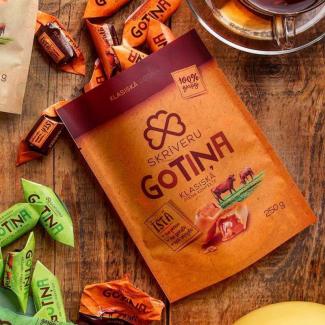
Latvian flavours in modern cuisine
Traditions of Latvian cuisine are not only preserved in the traditional ways of cooking but also take on a new form in modern cuisine. The use of local flavours and products is becoming increasingly important in Latvia.
The Chef’s House in Līgatne (Līgatnes Pavāru māja) is the right stop for anyone, who is willing to enjoy the local flavours, local products and forest delicacies in an exquisite menu. In this restaurant, the closeness of nature can not only be tasted on the plate, it can also be felt in the restaurant itself – it is located outside large cities and is surrounded by nature.
Latvian flavours can be enjoyed not only on a plate but also in drinks at the cocktail bar Gimlet Nordic, where lime is replaced by quince and seasonal natural delicacies such as nettles and green peas, and pine cones, local honey and other riches of nature are served in cocktails.

